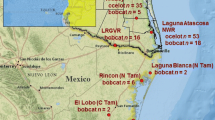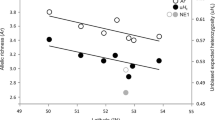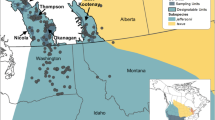Abstract
Over the past century, human activities and their side effects have significantly threatened both ecosystems and resident species. Nevertheless, the genetic patterns of large felids that depend heavily on large and well-conserved continuous habitat remain poorly studied. Using the largest-ever contemporary genetic survey of wild jaguars (Panthera onca), we evaluated their genetic diversity and population structure in natural (Brazilian Amazon) and highly modified habitats (e.g. Cerrado, Caatinga) including those close to the northern (Yucatan, Mexico) and southern (Pantanal) edge of the species’ distribution range. Data from our set of microsatellites revealed a pronounced genetic structure, with four genetically differentiated geographic areas. Geographic distance was not the only factor influencing genetic differentiation through the jaguar range. Instead, we found evidence of the effects of habitat deterioration on genetic patterns: while the levels of genetic diversity in the Amazon forest, the largest continuum habitat for the species, are high and consistent with panmixia across large distances, genetic diversity near the edge of the species distribution has been reduced through population contractions. Mexican jaguar populations were highly differentiated from those in Brazil and genetically depauperated. An isolated population from the Caatinga showed the genetic effects of a recent demographic decline (within the last 20–30 years), which may reflect recent habitat degradation in the region. Our results demonstrate that the jaguar is highly sensitive to habitat fragmentation especially in human-dominated landscapes, and that in Brazil, the existing but limited genetic connectivity in the central protected areas should be maintained. These conclusions have important implications for the management of wide-ranging species with high dispersal and low population density. The restoration of ecological connectivity between populations over relatively large scales should be one of the main priorities for species conservation.



Similar content being viewed by others
References
Alasaad S, Soriguer RC, Chelomina G et al (2011) Siberian tiger’s recent population bottleneck in the Russian far east revealed by microsatellite markers. Mamm Biol 76:721
Altrichter M, Boaglio G, Perovic P (2006) The decline of jaguars, Panthera onca, in the Argentine Chaco. Oryx 40:302–309
Belkhir K, Borsa P, Chikhi L, Raufaste N et al. (2004) Genetix 4.05: logiciel sous WindowsTM pour la génétique des populations. Laboratoire Génome, Populations, Interactions, CNRS UMR 5000, , Université de Montpellier II, Montpellier
Bohonak AJ (2002) IBD (isolation by distance): a program for analyses of isolation by distance. J Hered 93:153–154
Boom R, Sol CJA, Salimans MMM et al (1990) Rapid and simple method for purification of nucleic-acids. J Clin Microbiol 28:495–503
Casteleti CHM, Silva JMC, Tabarelli M, Santos AMM (2005) Quanto resta da Caatinga? Uma estimativa preliminar. In: Silva JMC, Tabarelli M, Da Silva JMC (eds) Ecologia e conservaçao da Caatinga. 2nd edn. Editoria Universitaria de UFPE, Recife, pp 719–734
Cavalcanti RB, Joly CA (2002) Biodiversity and conservation priorities in the cerrado region. In: Oliveira PS, Marquis RJ (eds) The cerrados of Brazil ecology and natural history of a neotropical savanna. Columbia University Press, New York, pp 351–367
Ceballos, GC, Chávez A, Rivera yC, Manterola (2002) Tamaño poblacional y conservación del jaguar (Panthera onca) en la Reserva de la Biosfera Calakmul, Campeche, México. Medellin RA, Chetkiewicz C, Rabinowitz A, Redford KH, Robinson JG, E. Sanderson yA Taber (eds) en: Jaguares en el nuevo milenio: Una evaluación de su estado, detección de prioridades y recomendaciones para la conservación de los jaguares en América. Universidad Nacional Autónoma de México/Wildlife Conservation Society, México, pp 403–481
Chávez C, Arana M, Ceballos G (2005) Panthera onca. In: Los mamíferos silvestres de México. Ceballos G and Oliva G (eds) CONABIO—UNAM—Fondo de Cultura Económica, MExico, pp 367–370
Ciofi C, Beaumont MA, Swingland IR et al (1999) Genetic divergence and units for conservation in the Komodo dragon, Varanus komodoensis. Proc R Soc Lond Ser B 266:2269–2274
Cornuet JM, Luikart G (1996) Description and power analysis of two tests for detecting recent population bottlenecks from allele frequency data. Genetics 144:2001–2014
Crawshaw PG Jr, Quigley HB (2002) Hábitos alimentarios del jaguar y el puma en el Pantanal, Brasil, con implicaciones para su manejo y conservación. In: El Jaguar en El Nuevo Milenio, Medellín RA, Equihua C, Chetkiewitcz CLB, Crawshaw PG Jr, Rabinowitz A, Redford KH, Robinson JG, Sanderson EW, Taber AB (eds) Fondo de Cultura Económica, Universidad Nacional Autónoma de México, México, Wildlife Conservation Society, New York, pp 223–236
Crooks KR (2002) Relative sensitivities of mammalian carnivores to habitat fragmentation. Conserv Biol 16:488–502
de Oliveira TG, Ramalho EE, de Paula RC (2012) Red List assessment of the jaguar in Brazilian Amazonia. CATnews Spec 7:8–13
Dutta T, Sharma S, Maldonado JE, Wood TC, Panwar HS, Seidensticker J (2013) Gene flow and demographic history of leopards (Panthera pardus) in the central Indian highlands. Evol Appl. doi:10.1111/eva.12078
Earl DA, vonHoldt BM (2011) STRUCTURE HARVESTER: a website and program for visualizing STRUCTURE output and implementing the Evanno method. Conserv Genet Resour. doi:10.1007/s12686-011-9548-7
Eizirik E, Kim JH, Menotti-Raymond M et al (2001) Phylogeography, population history and conservation genetics of jaguars (Panthera onca, Mammalia, Felidae). Mol Ecol 10:65–79
England PR, Luikart G, Waples RS (2010) Early detection of population fragmentation using linkage disequilibrium estimation of effective population size. Conserv Genet 11:2425–2430
Evanno G, Regnaut S, Goudet J (2005) Detecting the number of clusters of individuals using the software STRUCTURE: a simulation study. Mol Ecol 14:2611–2620
Frankham R (2003) Genetics and conservation biology. CR Biol 326:S22–S29
Frankham R (2005) Genetics and extinction. Conserv Biol 126:131–140
Frankham R, Lees K, Montgomery ME et al (1999) Do population size bottlenecks reduce evolutionary potential? Anim Conserv 2:255–260
Garza JC, Williamson EG (2001) Detection of reduction in population size using data from microsatellite loci. Mol Ecol 10:305–318
Gyllenberg M, Hanski I (1992) Single-species metapopulation dynamics: a structured model. Theor Popul Biol 42:35–62
Haag T, Santos AS, Sana DA et al (2010) The effect of habitat fragmentation on the genetic structure of a top predator: loss of diversity and high differentiation among remnant populations of Atlantic Forest jaguars (Panthera onca). Mol Ecol 19:4906–4921
Harley EH (2002) AGARST, version 2.8. A program for calculating allele frequencies, GST and RST from microsatellite data. Wildlife Genetics Unit, University of Cape Town, Cape Town
Harris MB, Tomas W, Mourão G et al (2005) Safeguarding the pantanal wetlands: threats and conservation initiatives. Conserv Biol 19:714–720
Henry P, Miquelle D, Sugimoto T et al (2009) In situ population structure and ex situ representation of the endangered Amur tiger. Mol Ecol 18:3173–3184
IUCN (2010) “IUCN SSC/Cat Specialist Group” (Online). http://www.catsg.org/catsgportal/20_catsg-website/home/index_en.htm. Accessed 29 Mar 2011
Janecka JE, Jackson R, Yuquang Z et al (2008) Population monitoring of snow leopards using noninvasive collection of scat samples: a pilot study. Anim Conserv 11:401–411
Joshi A, Vaidyanathan S, Mondol S, Edgaonkar A, Ramakrishnan U (2013) Connectivity of tiger (Panthera tigris) populations in the human-influenced forest mosaic of Central India. PLoS One 8(11):e77980. doi:10.1371/journal.pone.0077980
Kalinowski ST (2005) HP-RARE 1.0: a computer program for performing rarefaction on measures of allelic richness. Mol Ecol Notes 5:187–189
Luikart G, Cornuet JM (1998) Empirical evaluation of a test for identifying recently bottlenecked populations from allele frequency data. Conserv Biol 12:228–237
Luikart G, Ryman N, Tallmon DA, Schwartz MK, Allendorf FW (2010) Estimation of census and effective population sizes: the increasing usefulness of DNA-based approaches. Conserv Genet 11:355–373
Margules CR, Pressey RL (2000) Systematic conservation planning. Nature 405:243–253
Miquel C, Bellemain E, Poillot C et al (2006) Quality indexes to assess the reliability of genotypes in studies using non-invasive sampling and multiple-tube approach. Mol Ecol Notes 6:985–988
Mittermeier RA, Myers N, Thomsen JB, da Fonseca GAB, Olivieri S (1998) Biodiversity hotspots and major tropical wilderness areas: approaches to setting conservation priorities. Conserv Biol 12:516–520
Moreno VR, Grisolia AB, Campagnari F et al (2006) Genetic variability of Herpailurus yagouaroundi, Puma concolor and Panthera onca (Mammalia, Felidae) studied using Felis catus microsatellites. Genet Mol Biol 29:290–293
Navarro-Serment CJ, Lopez-Gonzalez CA, Gallo-Reynoso JP (2005) Occurrence of jaguar (Panthera onca) in Sinaloa, Mexico. Southwest Nat 50:102–106
Negroes N, Revilla E, Fonseca C et al (2011) Private forest reserves can aid in preserving the community of medium and large-sized vertebrates in the Amazon arc of deforestation. Biodivers Conserv 20:505–518
Noss R, Quigley HB, Hornocker MG et al (1996) Conservation biology and carnivore conservation in the rocky mountains. Conserv Biol 10:949–963
Nowell K, Jackson P (1996) Wild Cats: status survey and conservation action plan. IUCN/SSC Cat Specialist Group, Gland, p 406
Paetkau D, Slade R, Burden M, Estoup A (2004) Genetic assignment methods for the direct, real-time estimation of migration rate: a simulation-based exploration of accuracy and power. Mol Ecol 13:55–65
Palomares F, Godoy JA, Lopez-Bao JV et al (2012) Possible extinction vortex for a population of iberian lynx on the verge of extirpation. Conserv Biol 26:689–697
Perez CA (2001) Synergistic effects of subsistence hunting and habitat fragmentation on Amazonian forest vertebrates. Conserv Biol 15:1490–1505
Piry S, Luikart G, Cornuet JM (1999) BOTTLENECK: a computer program for detecting recent reductions in the effective population size using allele frequency data. J Hered 90:502–503
Piry S, Alapetite A, Cornuet JM, Paetkau D, Baudouin L, Estoup A (2004) GENECLASS2: a software for genetic assignment and first-generation migrant detection. J Hered 95:536–539
Rabinowitz A, Zeller KA (2010) A range-wide model of landscape connectivity and conservation for the jaguar, Panthera onca. Biol Conserv 143:939–945
Reddy PA, Kumaraguru A, Yadav PR et al (2011) Studies to determine presence or absence of the Indian tiger (Panthera tigris tigris) in Kawal Wildlife Sanctuary, India. Eur J Wildl Res 57:517–522
Reed DH, Lowe EH, Briscoe DA, Frankham R (2003) Inbreeding and extinction: effects of rate of inbreeding. Conserv Genet 4:405–410
Roeder AD, Archer FI, Poiner HN, Morin PA (2004) A novel method for collection and preservation of faeces for genetic studies. Mol Ecol Notes 4:761–764
Roques S, Adrados B, Chavez C et al (2011) Identification of neotropical felid faeces using RCP-PCR. Mol Ecol Resour 11:171–175
Roques S, Furtado M, Jácomo ATA et al (2014) Monitoring jaguar populations (Panthera onca) with non-invasive genetics: a pilot study in Brazilian ecosystems. Oryx. doi:10.1017/S0030605312001640
Rosas-Rosas OC, Bender LC (2012) Population status of jaguars (Panthera onca) and pumas (Puma concolor) in northeastern Sonora, Mexico. Acta Zool Mex 28:86–101
Rousset F (2008) Genepop’007: a complete reimplementation of the Genepop software for windows and Linux. Mol Ecol Resour 8:103–106
Ruiz-García M, Payán E, Murillo A, Alvarez D (2006) DNA Microsatellite characterization of the Jaguar (Panthera onca) in Colombia. Genes Genet Syst 81:115–127
Ruiz-García M, Murillo A, Corrales C, Romero-Aleán N, Alvarez-Prada D (2007) Genética de Poblaciones Amazónicas: la historia evolutiva del jaguar, ocelote, delfín rosado, mono lanudo y piurí reconstruida a partir de sus genes. Anim Biodivers Conserv 30:115–130
Rylands AB, Brandon K (2005) Brazilian protected areas. Conserv Biol 19:612–618
Saccheri I, Kuussaari M, Kankare M et al (1998) Inbreeding and extinction in a butterfly metapopulation. Nature 392:491–494
Sambrook J, Fritschi EF, Maniatis T (1989) Molecular cloning: a laboratory manual. Cold Spring Harbor Laboratory Press, New York
Sanderson EW, Redford KH, Chetkiewicz CLB et al (2002) Planning to save a species: the jaguar as a model. Conserv Biol 16:58–72
Sharma S, Dutta T, Maldonado JE, Wood TC, Panwar HS, Seidensticker J (2013) Forest corridors maintain historical gene flow in a tiger metapopulation in the highlands of central India. Proc R Soc B 280:20131506. doi:10.1098/rspb.2013.1506
Shivik JA (2006) Tools for the Edge: what’s new for conserving carnivores. Bioscience 56:253–259
Silveira L, Jacomo ATA, Astete S et al (2010) Density of the near threatened jaguar panthera onca in the caatinga of North-Eastern Brazil. Oryx 44:104–109
Silveira L, Sollmann R, Jacomo ATA et al (2014) The potential for large-scale wildlife corridors between protected areas in Brazil using the jaguar as model species. Landsc Ecol 29:1213–1223
Slatkin M (1995) A measure of population subdivision based on microsatellite allele frequencies. Genetics 139:457–462
Soisalo MK, Cavalcanti SMC (2006) Estimating the density of a jaguar population in the Brazilian Pantanal using camera-traps and capture-recapture sampling in combination with GPS radio-telemetry. Biol Conserv 129:487–496
Sollmann R, Tôrres NM, Silveira L (2008) Jaguar conservation in Brazil: the role of protected areas. CAT News 4:15–20 (The Jaguar in Brazil)
Srikwan S, Woodruff DS (2000) Genetic erosion in isolated small mammal populations following rain forest fragmentation. In: Young A, Clarke G (eds) Genetics, demography and viability of fragmented populations. Cambridge University Press, Cambridge, pp 149–172
Swartz FA (2000) The pantanal in the 21st century—for the planet’s largest wetland, an uncertain future. In: Swartz FA (ed) The pantanal of Brazil, paraguay and Bolivia. Hudson MacArthur Publishers, Gouldsboro, pp 1–24
Taberlet P, Waits LP, Luikart G (1999) Noninvasive genetic sampling: look before you leap. Trends Ecol Evol 14:321–325
Tallmon DA, Koyuk A, Luikart G, Beaumont MA (2008) ONeSAMP: a program to estimate effective population size using approximate Bayesian computation. Mol Ecol Resour 8:299–301
Thompson WL (2004) Sampling rare or elusive species: concepts, designs, and techniques for estimating population parameters. Island Press, Washington
Vucetich JA, Waite TA (2003) Spatial patterns of demography and genetic processes across the species’ range: null hypotheses for landscape conservation genetics. Conserv Genet 4:639–645
Vynne C, Keim JL, Machado RB et al (2011a) Resource selection and its implications for wide-ranging mammals of the Brazilian Cerrado. Plos One 6:e28939–e28939
Vynne C, Skalski JR, Machado RB et al (2011b) Effectiveness of scat-detection dogs in determining species presence in a tropical savanna landscape. Conserv Biol 25:154–162
Waples RS, Do C (2008) LDNE: a program for estimating effective population size from data on linkage disequilibrium. Mol Ecol Resour 8:753–756
Weir BS, Cockerham CC (1984) Estimating F-statistics for the analysis of population-structure. Evolution 38:1358–1370
Williams BK, Nichols JD, Conroy MJ (2002) Analysis and management of animal populations. Academic Press, San Diego
Zeller K (2007) Jaguars in the new millennium data base update: the state of the jaguar in 2006. Wildlife Conservation Society-Jaguar Conservation Program, New York
Acknowledgments
This study was carried out with the support of the project BIOCON 05—100/06 of the Fundación BBVA, the project CGL2010-16902 of the Spanish Ministry of Research and Innovation, the project CGL2013-46026-P of MINECO, the excellence project RNM 2300 of the Junta de Andalucía, and projects UAM-PTC-333 and PROMEP/103.5/12/3823. Sampling in the Mexican areas under the license SGPA/DGVS/549 provided by Martín Vargas of the Dirección General de Vida Silvestre (Semarnat). Faecal samples were exported from Mexico to Spain under the export licences no MX33790 and MX42916 of the Secertaria de Medio Ambiente/CITES. Sampling in Brazil was carried out in RAPELD sites installed or maintained by the Brazilian Program for Biodiversity Research (PPBio) and under licenses #131/2005 CGFAU/LIC, 13883-1 SISBIO and 15664-1 SISBIO of the Instituto Brasileiro do Meio Ambiente—IBAMA. Faecal samples were exported from Brazil to Spain for genetic analysis under IBAMA/CGEN Autorização de Acesso license #063/05 and IBAMA/CITES export licenses #0123242BR and 08BR002056/DF”. We thank the management of the Edén Ecological Reserve (Marco Lazcano) and El Zapotal Ecological Reserve (Pronatura Península de Yucatán: Juan Carlos Faller and María Andrade) for their logistical support. We are grateful to J.S. Lópes and J. Tavares for the collection of most of the field samples in Brazil. Julia Martínez, Gloria Clemencia Amaya, Juan Carlos Faller, Meredic Calleja and Ana Alicia Morales helped with the fieldwork in Brazil and Mexico, as well as the local reserve staff of El Zapotal and El Edén (Mexico). L. Soriano and A. Piriz provided technical advice on multiple issues, and A. García, E. Marmesat, and B. Gutiérrez assisted in the analysis of samples. Logistical support was provided by Laboratorio de Ecología Molecular, Estación Biológica de Doñana, CSIC (LEM-EBD). The Spanish Ministry of Education and Sciences supported the visit of S. Roques in Mexico. We thank Manuela Gonzalez-Suarez and Philip Hedrick for an early revision of the manuscript.
Author information
Authors and Affiliations
Corresponding author
Electronic supplementary material
Below is the link to the electronic supplementary material.
Rights and permissions
About this article
Cite this article
Roques, S., Sollman, R., Jácomo, A. et al. Effects of habitat deterioration on the population genetics and conservation of the jaguar. Conserv Genet 17, 125–139 (2016). https://doi.org/10.1007/s10592-015-0766-5
Received:
Accepted:
Published:
Issue Date:
DOI: https://doi.org/10.1007/s10592-015-0766-5




